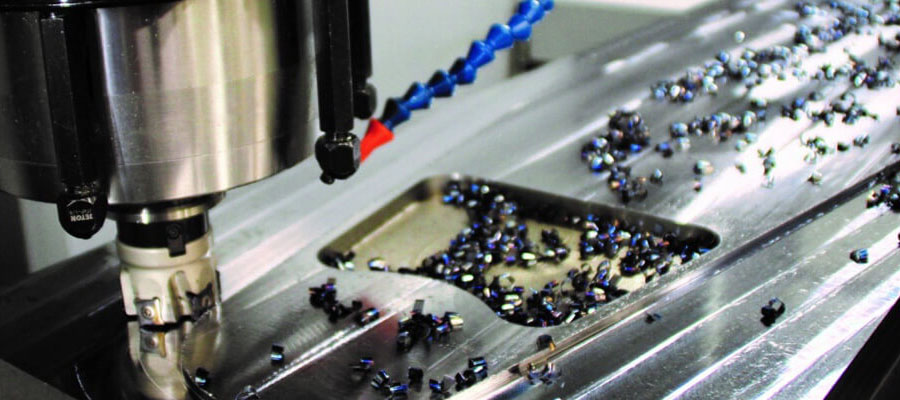Computer digital machining (CNC) machining is an important process used to form parts from different metals, plastics, and composite materials. CNC machining ensures high repeatability and precision, making it ideal for a variety of manufacturing applications.
CNC machining is a comprehensive term for a variety of machining processes including CNC turning, CNC milling, and CNC drilling. Among them, CNC milling is an important CNC machining process used in the production of industrial and commercial components.
CNC milling machines combine the accuracy of computer control to rotate and position multi-point cutting tools. As the raw material passes through the pre-programmed machining operations, the tool moves along the X, Y, and Z three spindles to accurately cut the material. For complex geometries, a 5-axis CNC milling machine will move along three linear axes and move along two rotary axes at the same time.
What are the types of CNC milling performed in the CNC machining workshop? Read this article to understand the answer.

Plain Milling
Plain milling is used to machine flat and horizontal surfaces. This type of milling is also called slab milling. This milling process uses cutting tools to remove material along the surface of the workpiece. In face milling, the axis of rotation is parallel to the workpiece. According to the movement between the worktable and the material, plain milling can be divided into down milling and down milling. It is accomplished by mounting the workpiece on the surface parallel to the milling machine table and the tool on the standard milling machine spindle.
Face Milling
Face milling is the machining of a plane at right angles to the tool axis. The tool used for this process has teeth on the periphery and the tool face. Each group of teeth has a specific function, the peripheral teeth are cut, and the face teeth are finished. Face milling can produce a higher quality finish and can be used in vertical or horizontal methods.
Compared with tools used for face milling, tools used for material removal have multiple teeth. The teeth in contact with the flat material are used for finishing, while the teeth on the edge are used to cut the raw material.
Angular Milling
In this type of milling, the cutting tool is at a specific angle to the surface of the workpiece. The corner groove may have a single angle or a double angle. It is used for milling planes that are neither parallel nor perpendicular to the tool axis.
This milling method places the rotation axis of the cutting tool at an angle with the surface of the workpiece to produce a design-specified angle cut, such as a groove or a dovetail.
Dovetail milling is a typical example of angle milling. According to the design, the angle of the tool is 45°, 50°, 55° or 60°. First use the side milling cutter to rough the tongue or groove, and then use the corner milling cutter to finish the corner edges and bottom.
Form Milling
In forming milling, forming tools are used to produce parts with irregular contours. Non-planar cutting is possible, such as contours, curves and radii. Each type of curve requires a specific cutting tool to create accurate shape cuts.
Shape milling is a function of milling irregular surfaces (such as curved planes or all curves). It can be formed into a cutting contour using a forming milling cutter or a flying knife, and the forming can be completed in one cut. Common form milling includes milling semi-circular grooves and beads or quarter radius on the workpiece. The types of cutters used for forming milling include convex, concave and round cutters, which can be ground to the required circle diameter. Form milling can create complex patterns or mill multiple complex surfaces in one cut. Hemispherical and semi-circular cavities, beads and contours can also be shaped by this process.
Straddle Milling
Straddle milling uses a pair of side milling cutters to machine two parallel surfaces of the workpiece. The knives are placed in opposite directions, and they are placed so that the workpiece is straddled by them. This type of milling is more suitable for milling several vertical surfaces in one cut.
In straddle milling, two or more parallel vertical surfaces are machined in one cut. This is achieved by mounting two milling cutters on the same tool holder and separating them by the exact width of the workpiece. Both sides of the workpiece are processed at the same time, and the size is accurately controlled. The workpiece is mounted on an indexing fixture or a vertical rotating vise.
Gang Milling
In gang milling, multiple milling cutters are used to cut different horizontal planes on a toolholder. The tools used in this process have different diameters, and the tool speed is calculated from the tool with the largest diameter.
Combination milling is to process multiple surfaces of the workpiece at the same time by feeding the workpiece into multiple tools that may have the same or different diameters. This process can perform more complex cutting on complex parts and shorten production time. If the workpiece needs to be cut multiple times, such as grooves, flats and corner grooves, row milling is the perfect choice.
The advantages of CNC milling include its ability to cut a variety of materials and produce custom-designed parts faster than traditional machining. Experienced CNC machining service providers know better which type of milling should be used. If you are looking for a trusted and experienced CNC machining service provider for your next project, then you can consider SANS Machining.



I like that you pointed out how CNC milling machines combine the accuracy of computer control to rotate and position multi-point cutting tools. I was reading a technical book earlier and I read a bit about milling machines. From what I’ve read, it looks like there are now milling machine shops, which seems very useful.